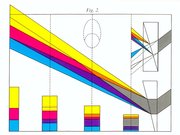Prism (optics)
|
|
PrismAndLight.jpg
In optics, a prism is a device used to refract light, reflect it or break it up (to disperse it) into its constituent spectral colours (colours of the rainbow), traditionally built in the shape of a right prism with triangular base.
As light moves from one medium (e.g. air) to another denser medium (the glass of the prism), it is slowed down and as a result either bent (refracted) or reflected. The angle that the beam of light makes with the interface as well as the refractive indices of the two media determine whether it is reflected or refracted, and by how much (see refraction, total internal reflection).
Reflective prisms are used to reflect light, for instance in binoculars, since they are easier to manufacture than mirrors. Dispersive prisms are used to break up light into its constituent spectral colours because the refractive index depends on frequency (see dispersion); the white light entering the prism is a mixture of different frequencies, each of which gets bent slightly differently. Blue light is slowed down more than red light and will therefore be bent more than red light. There are also polarizing prisms which can split a beam of light into components of varying polarization.
Isaac Newton first thought that prisms split colours out of colourless light. Newton placed a second prism such that a separated colour would pass through it and found the colour unchanged. He concluded that prisms separate colours. He also used a lens and a second prism to recompose the rainbow into white light.
Prismatic Spectrum as a Compound Phenomenon
According to Goethe, when light shines through a prism, we are simply projecting a picture whose aperature has edges -- there is darkness outside this circular patch, and relatively light within it. We notice that it is at the edges between the light and dark areas where Colours first make their appearance.
When the aperature is sufficiently small so that the edges meet in the middle to form the green -- only then can you see a continuous spectrum. A wider aperature brings us to the primal phenomenon -- a reddish/yellow on some edges, and a bluish/cyan on the others. The continuous spectrum with green in the middle arises only where the (blue-cyan and yellow-red) edges come close enough to overlap.
We no longer see the original phenomenon when we make so small a circle that the colours extend inward from the edges to overlap in the middle to form what is called a 'continuous spectrum', while with the larger circle, the colours formed at the edges stay as they are.
Thus, for Goethe, the primal phenomenon is that Colours arise at the borders where Light and Dark work together, and the Spectrum is a secondary, compound phenomenon.
Types of prisms
Reflective prisms:
Dispersive prisms:
Polarizing prisms:
See also
de:Prisma (Optik) es:Prisma (óptica) fr:Prisme (optique) id:Prisma (optik) nl:Prisma (optica) ja:プリズム pl:Pryzmat fi:Prisma (optiikka) vi:Lăng kính


